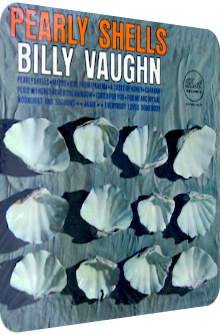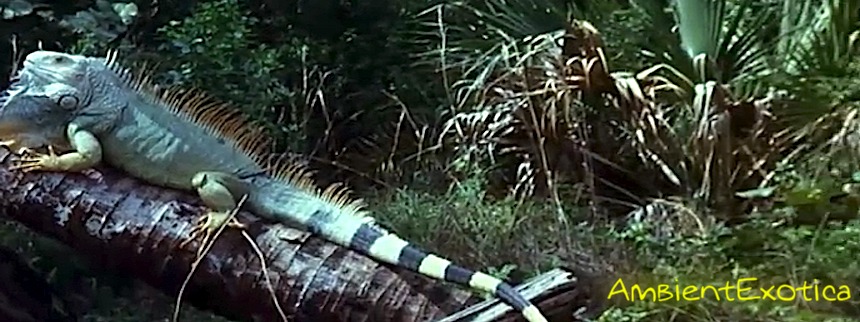
Billy Vaughn
Pearly Shells
1964
Pearly Shells by multi-instrumentalist Billy Vaughn (1919–1991) is an Exotica album. "Well… duh," I hear some readers say, but this bold assertion is neither picayune nor de trop, not at all. Vaughn's brass-heavy arrangements are famous and loved in Germany and Austria, but infamous and loathed everywhere else. It is not even the quantity of the trumpeters or trombonists he uses, for only one or two of them usually occur at the same time in a rendition. No, it is their texture and surface that is wrong and out of place, at least in Vaughn's records that could be counted to the Exotica genre due to their album titles and the presented material. Pearly Shells does not differ from the previous formulae, it still relies one too many times on horns, but it also shows a curious yet utterly welcome trend: Vaughn’s music becomes more and more exotic as the years progress, in a way still resembling corny kitsch, but camouflaging it much better in an overall semi-enchanting package. Indeed, Pearly Shells lives up to the faux-Polynesian hype.
Released in 1964 on Dot Records, it features Billy Vaughn on the vibraphone as well as a bunch of unmentioned session musicians and regular bandmembers on alto flutes, ukuleles, the Hammond organ, exotic percussion and those pesky brass instruments. The 12 interpretations of well-known classics are truly enchanting at times, perfectly soothing and neither all too demanding nor unnecessarily forseeable. That the density of the arrangements evokes Polynesian beaches, jungles and hammock-compatible dreamscapes is nothing short of a surprise, for the back cover fuels the worst nightmares: Billy Vaughn is shown with a forester-like hat and a pipe. Not exactly exotic. There are photographs which depict Vaughn with a lei, so I don't know where the people at Dot Records had their heads in that moment. Luckily, it is just a chintzy archival photograph! As usual, I dare a closer look at all of the twelve cuts below while keeping my positive bewilderment in mind: is that really a track by Billy Vaughn that is playing? Why does it sound so perfectly exotic and pacific?
Léon Pober’s and Ralph Rainger’s Pearly Shells marks the beginning, remaining faithfully committed to the formula of blandness in that the first tune of a Billy Vaughn album shows the tendency of being the title track. Same here. Pearly Shells launches with diffusely droning timpani, bamboo rods and maracas which are then united with a warm acoustic guitar-interspersed vibraphone apparition of the well-known Polynesian melody, played by Vaughn himself. Paradisiac flutes and the glinting glissando of pianos alternate with the vibes. Say what you will, but Billy Vaughn succeeds with this opener, even big time considering the main body of his complete works. The percussion scheme is top-notch, always churning, dripping and grinding along to the tropical breeze.
The rendition of Peg O’ My Heart, originally written by Alfred Bryan and Fred Fisher, is a letdown in comparison, even more so since its prelude is great due to its helix of vibe sustain washes, dreamy flute tittles and careful ukulele accents. Before the mark of 30 seconds already, things get worse, and I blame the sugar-coated violins for this. Their textural quality is okay, the tonal range is all too romantic. On the plus side, there is a gorgeous Hammond B3 Space-Age organ on board, but its welcome impetus is again diminished by a melodramatic trumpet sequence which then leads to a dreamland that resembles the opening phase. Again, the ingredients are all fine, but the tonal ranges and the unnecessarily fiery play style prove to be toxic for the Polynesian lushness.
Arthur Freed’s I Cry For You might imply that the worst is yet to come, but the opposite is the case, for it is the best tune of side A! Surf Rock-alluding guitar strata of a sun-dried physiognomy coalesce with a laid-back bongo groove, a curious but well-working choice given the composition’s midtempo physique. The piano gleams and glows euphoniously, the vibraphone sparkles gelidly and injects a cool breeze. The flute work is particularly great, and thank the tiki gods that there are no trumpets or strings attached, so to speak. A wonderful tune that is surprisingly carefree and lofty given its title. While Irving Taylor’s world-famous Everybody Loves Somebody is presented here in an awful exotropia of pale strings and a too acidic trumpet melody, Bobby Scott’s and Ric Marlow’s A Taste Of Honey is another hallmark that is as good as Martin Denny’s take – believe it or not – because of the delicate fuzziness that lies like a veil over the vibraphone-piano undulations, with only the glockenspiels, occasional wind chimes and yearning flute towering above the mellowness.
Side A closes with a hybrid of which I cannot say anything particularly mean, for I pity the lost chance of something greater: Antonio Carlos Jobim’s A Girl From Ipanema kicks off in a splendid fashion, with a fantastic bongo and conga thicket, sun-dappled flute airflows and Billy Vaughn on the emerald vibes. The interplay, the unity, everything floats… that is until a tenor saxophone enters the scenery which is too piercing and destroys the whole sections it is used in. Balearic guitars and yellow-tinged piano notes then have to iron out these protuberances, with Vaughn finishing the composition off with an encore on the vibes. If it were not for the sax, A Girl From Ipanema would have been the best tune.
Side B opens with George Gershwin’s Maybe, and yet again does Mr. Vaughn prove he has reached the shores of Exotica. This is a wondrous little ditty of 90 seconds full of iridescent vibes of lullaby allusions, their sustain fades into the backing strings, the bamboo rods clang next to the frizzling maracas, quiescent ukuleles function as another backbone, everything is perfect until a short trumpet infusion is unleashed near the end, played so much over the top that its tasteless appearance morphs into cheeky grandeur. I’m laughing to this day whenever I hear it. Whereas For Me And My Gal by Edward Ray Goetz, Edgar Leslie and George W. Meyer is the album’s second-fastest critter below the two minute mark with Mexican horns, jazzy vibraphone spirals and Latin staccato piano aortas of the gleeful kind in adjacency to flute washes, Duke Ellington’s Caravan takes the cake when it comes to tempo, frantic percussion placentas, Oriental flutes, and cascading vibe tones, making it the most dynamic tune Billy Vaughn has ever interpreted.
I have heard far worse takes on Caravan. It is Moonlight And Shadows by Frederick Hollander and Leo Robin that exchanges tempo for a strong aura of nocturnal peacefulness. Xylophones, glockenspiels and vibraphones whirr around a soothing yet upfront shrapnel on the ukulele, an alto flute wafts in the air, and the hefty vibrato of the trumpets marks the end of this tune at the right time. Edgar »Yip« Harburg’s and Harold Arlen’s Over The Rainbow is the expected berceuse with added Honky Tonk pianos, gorgeously glittering star dust fragments and the inscrutable use of the blazing trumpet. Why oh why? The languorous balm is washed away and only returns in the outro Again, a guitar- and ukulele-underlined vibraphone piece with effervescent flutes and a gentle Rock rhythm complete with rolling timpani and a polyphony to die for. The insipid side B ends with a great tune.
Billy Vaughn’s Pearly Shells is undoubtedly a vintage Exotica artifact recorded during the genre’s sunset phase. As usual, Vaughn is a bit behind the competition, but despite my snarky comment, the album’s saccharine arrangements do not cause indigestions or upset stomachs. A Polynesian aura is incessantly apparent, not just in the title track – Blue Hawaii (1959) and Mexican Pearls (1965) come to mind – but throughout the whole material. The omnipresence of the vibraphone is a boon, and while one should neither hope for eclectic structures nor a maximum of enchanting decay or sustain phases, Vaughn's pittoresque spirals leave the Easy Listening paths quite often.
The usage of the ukulele is surprisingly reduced, and given the overarching theme of the album, some listeners might perceive this as a flaw, but that is up for debate. What is not up for debate, though, is the inclusion of the Hammond organ in Peg O' My Heart which injects a glob of Space-Age into the album, and I believe that if the organ had been used more frequently, the other tracks would have profited, as they suffer from the infamous instrument Billy Vaughn weaves far too often into his style: the trumpet in particular and brass instruments in general. What made him famous in Schlagerland Germany causes quite a negative stirr everywhere else, likewise on Pearly Shells.
These brazen instruments are mixed in a wrong way, instead of ennobling the aurora with a mild-mannered, whitewashed style, they cut through the vibraphone-laden panorama and throw the carefully maintained balance out the window. I do not mind trumpets in Latin music or big band settings and actually embrace them in these constellations, but Pearly Shells is a quartet-esque album rather than a symphonic one and hence far too fragile for their frequent occurrence. That said, Pearly Shells continues Billy Vaughn's 60's trend of delivering albums which target (and fulfill) the specific needs of the Exotica crowd. It has its flaws, but strong outings as well. Since it is constantly reissued on CD and digital download versions, you can pick your favorite tracks. The whole album is probably not worth it, but your mileage may vary. Now off to Arthur Lyman's Pearly Shells…
Exotica Review 499: Billy Vaughn – Pearly Shells (1964). Originally published on Sep. 19, 2018 at AmbientExotica.com.
